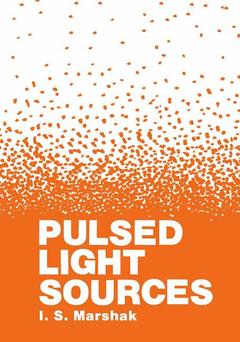Pulsed Light Sources, Softcover reprint of the original 1st ed. 1984
Langue : Anglais
Auteur : Marshak I.

The extensive development of electronics and automation equip ment defines the scientific and technical significance of all types of high-density energy converters that are used in electronic and automatic equipment. A powerful pulsed discharge in gas is one type of conversion of electrical energy into extremely intense optical radiation. In order to characterize the possibilities inherent in such a discharge, it suffices to recall that high-power lasers were first developed by using flashlamps based on precisely this kind of discharge. The correct use of existing types of flashlamps, work toward developing new types of flashlamps, and the solution of new problems by using such flashlamps require a knowledge of the physical processes that occur in them and the relationship between their technical characteristics and their design data and power-supply parameters. An acquaintance with the variety of existing flashlamps and the cir cuits used in the equipment employing them also is needed.
1 Physical Processes in Pulsed Discharges.- 1 Development of Discharge: Electrical Breakdown of Gas at Near-Atmospheric Pressures.- 1-1. Classification of Types of Breakdown.- 1-2. Breakdowns of Types A and C.- 1-3. Type E Breakdown.- 2 High-Current Pulsed Discharge with an Expanding Channel.- 2-1. Primary Current Rise Before Channel Expansion.- 2-2. The Theory of Discharge Expansion.- 2-3. Channel Expansion in Tubular Lamps.- 2-4. Free Expansion of the Discharge.- 2-5. The Luminance of a Freely Expanding Discharge.- 3 Pulsed Discharge of the Quasi-Stationary type.- 3-1. Local Thermodynamic Equilibrium in a High-Pressure Discharge.- 3-2. Diagnostics of the Quasi-Stationary Stage of a Pulsed Discharge in Tubular Lamps.- 3-3. Elements of the Energy Balance, and the Electrical Properties of a Quasi-Stationary Plasma.- 3-4. Radiative and Absorptive Properties of a Quasi-Stationary Plasma.- 3-5. Calculation of the Characteristics of a Pulsed Discharge Having a Quasi-Stationary Stage.- 4 Phenomena at Electrodes.- 4-1. General Information.- 4-2. The Cathode Spot.- 4-3. Electrode Sputtering.- 2 Gas-Discharge Flashlamps.- 5 Radiation Characteristics of Flashlamps.- 5-1. General Information on Flashlamps.- 5-2. The Main Photometric Characteristics of Pulsed Light Sources.- 5-3. Light Characteristics of Tubular Flashlamps.- 5-4. Light Characteristics of Spherical Flashlamps.- 5-5. The Spatial Distribution and Polarization of the Radiation from Flashlamps.- 5-6. The Spectral Characteristics and Efficiency of Flashlamps.- 5-7. The Spectral Characteristics of Spherical Flashlamps.- 5-8. The Effect of an Optical System on a Flashlamp.- 5-9. The Stability of Flashlamp Radiation.- 6 The Load Characteristics of Flashlamps.- 6-1. A Survey of Load Limits.- 6-2. The Load Limits on Leads.- 6-3. The Load Limits of Tubular Lamps During Single-Flash Operation.- 6-4. Possible Mechanisms of Failure in Tubular Lamps.- 7 Operating Characteristics of Flashlamps.- 7-1. Starting Characteristics.- 7-2. Frequency Response.- 7-3. Operating Life.- 7-4. Mechanical and Climatic Properties, and Other Operating Features.- 8 Industrial Production of Flashlamps.- 8-1. The Main Features Used to Classify Lamps.- 8-2. Design Principles and Production Processes.- 8-3. The Product Range of Flashlamps.- 9 Circuit Diagrams of Flashlamps and the Main Circuit Elements.- 9-1. The Functional Power-Supply Diagram of a Flashlamp.- 9-2. DC Power-Supply Circuits without Energy Storage Devices.- 9-3. Power-Supply Circuits Using an AC Supply Line with No Storage Devices.- 9-4. General Characteristics of Circuits Using Capacitive Storage Devices.- 9-5. A Survey of the Different Types of Chargers.- 9-6. Inductive Storage Devices.- 9-7. The Discharge Circuit.- 9-8. The Main Elements of the Discharge Circuit.- 9-9. Triggering Devices.- 9-10. Control, Synchronization, and Protective Devices.- 10 The Interaction of Radiation Pulses with Detectors.- 10-1. Pulsed-Radiation Detectors.- 10-2. Methods of Measuring the Parameters and Characteristics of Pulsed Light Sources.- References.
Date de parution : 09-2013
Ouvrage de 461 p.
17.8x25.4 cm
Disponible chez l'éditeur (délai d'approvisionnement : 15 jours).
Prix indicatif 52,74 €
Ajouter au panier
© 2024 LAVOISIER S.A.S.



